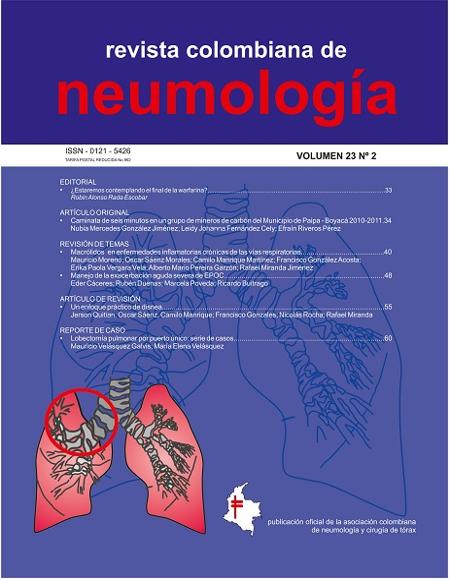Management of severe acute exacerbations of COPD.
Manejo de la exacerbación aguda severa de EPOC
Ninguna publicación, nacional o extranjera, podrá reproducir ni traducir sus artículos ni sus resúmenes sin previa autorización escrita del editor; sin embargo los usuarios pueden descargar la información contenida en ella, pero deben darle atribución o reconocimiento de propiedad intelectual, deben usarlo tal como está, sin derivación alguna.
Show authors biography
AECOPD (acute exacerbation of chronic pulmonary disease) is a frequent motive of presentation to emergency services. When severe, it usually requires management at an intermediate or intensive care unit, where adequate monitoring and ventilatory assistance can be provided. A review was carried out of the literature on the evaluation, management, and follow-up of severe AECOPD, with emphasis on the rationale and indications of noninvasive mechanical ventilation (NIMV), as well as on the assessment of the patient once this therapy has been initiated. NIMV is currently the firstchoice treatment in patients with AECOPD with impending or actual hypercapnic ventilatory failure, and has shown significant benefits in terms of recovery and survival. It is important to supplement clinical evaluation with arterial blood gas analysis, which allows initial focusing and afterwards serves as a guideline for timely decisions.
Article visits 2275 | PDF visits 9026
Downloads
- Rodríguez-Roisin R. Toward a concensus definition for COPD exacerbation. Chest. 2000;117;398S-401S
- Garcia-Aymerich J, Barreiro E, Farrero E, Marrades RM, Morera J, Antó JM. Patients hospitalized for COPD have a high prevalence of modifiable risk factors for exacerbation (EFRAM study). Eur Respir J. 2000 Dec;16(6):1037-42.
- Bahadori K, FitzGerald JM, Levy RD, Fera T, Swinston J. Risk factors and outcomes associates with chronic obstructive pulmonary disease exacerbations requiring hospitalization. Can Res J. 2009; 168: 71-79
- Rothberg M., Pekow P., et al. Antibiotic Therapy and Treatment Failure in Patients Hospitalized for Acute Exacerbations of Chronic Obstructive Pulmonary Disease. JAMA, May 26, 2010.
- Daniels JM, Snijders D, de Graaff CS, Vlaspolder F, Jansen HM, Boersma WG. Antibiotics in addition to systemic corticosteroids for acute exacerbations of chronic obstructive pulmonary disease. Am J Respir Crit Care Med. 2010 Jan 15.
- Anthonisen NR, Manfreda J, et al. 1987. Antibiotic therapy in exacerbations of chronic obstructive pulmonary disease. Ann Intern Med, 106:196–204.
- Siddiqi A., Sethi S.. Optimizing antibiotic selection in treating COPD exacerbation. International Journal of COPD 2008:3(1) 31–44.
- Schuetz P., D. Leuppi, Tamm M., Short versus conventional term glucocorticoid therapy in acute exacerbation of chronic obstructive pulmonary disease. REDUCE trial. Swiss Med Wkly. 2010;140.
- ATS/ ERS Task Force. Eur Respir J 2004; 23: 932–946
- Nava S., Hill N.. Non-invasive ventilation in acute respiratory failure. Lancet . 2009; 374: 250–59.
- Carrera M., Marín J., Antón A. A controlled trial of noninvasive ventilation for chronic obstructive pulmonary disease exacerbations. Journal of Critical Care (2009) 24, 473.e7–
- e14 .
- G U Meduri, N Abou-Shala, R C Fox, C B Jones, K V Leeper and R G Wunderink. Noninvasive face mask mechanical ventilation in patients with acute hypercapnic respiratory failure. Chest. 1991;100;445-454
- British Thoracic Society Standards of Care Committee. Noninvasive ventilation in acute respiratory failure. Thorax 2002;57:192–211.
- Masip J. Ventilación no invasiva en el edema agudo de pulmón. Hipertensión. 2008;25(1):16-22
- Esmond G., Mikelsons C.. Non invasive respiratory support techniques. 1a edición. Oxford, UK. Blackwell Publishing. 127–152
- Des Jardins T. Cardiopulmonary anatomy and physiology. 4th edition. Columbia. USA. Delmar/Thomnson learning. 63 – 115.
- Levitzky M. Pulmonary Physiology. 7th edition. Mc Graw Hill’s ed. USA. Cap. 3.
- Khilnani G., Banga A. Noninvasive ventilation in patients with chronic obstructive airway disease. International Journal of COPD 2008:3(3) 351–357
- Mckenzie I. Core Topics in mechanical ventilation. 1st edition. Cambridge. Cambridge University Press. 32–53.
- Elliot M. Non invasive mechanical ventilation. Medicine. 2004. 99–102.
- Antro C, Merico F, Urbino R, Gai V. Non-invasive ventilation as a first-line treatment for acute respiratory failure: «real life» experience in the emergency department. Emerg Med J. 2005 Nov;22(11):772-7
- Kaya A,Çiledag A, Çayli I, Önen Z, et al. Associated factors with non-invasive mechanical ventilation failure in acute hypercapnic respiratory failure. Tüberküloz ve Toraks Dergisi. 2010; 58(2): 128-134
- Ferrer M, Sellarés J, Valencia M, Carrillo A. Non-invasive ventilation after extubation in hypercapnic patients with chronic respiratory disorders: randomised controlled trial. Ann Intern Med. 2010 Feb 16; 152(4): JC-24.
- Khilnani GC, Saikia N, Banga A, Sharma SK. Non-invasive ventilation for acute exacerbation of COPD with very high PaCO(2): A randomized controlled trial. Lung India. 2010 Jul;27(3):125-30.
- Prasad SB, Chaudhry D, Khanna R. Role of noninvasive ventilation in weaning from mechanical ventilation in patients of chronic obstructive pulmonary disease: an Indian experience. Indian J Crit Care Med. 2009 Oct;13(4):207-12
- Carrera M, Marín JM, Antón A, et al. A controlled trial of noninvasive ventilation for chronic obstructive pulmonary disease exacerbations. J Crit Care. 2009 Sep;24(3):473.e7-14.
- Purro A, Appendini L, Polillo C, et al. Mechanical determinants of early acute ventilatory failure in COPD patients: a physiologic study. Intensive Care Med. 2009 Apr;35(4):639-47.
- Joosten SA, Koh MS, Bu X, et al. The effects of oxygen therapy in patients presenting to an emergency department with exacerbation of chronic obstructive pulmonary disease. Med J Aust. 2007 Mar 5;186(5):235-8.
- Mohan A, Premanand R, Reddy LN, et al. Clinical presentation and predictors of outcome in patients with severe acute exacerbation of chronic obstructive pulmonary disease requiring admission to intensive care unit. BMC Pulm Med. 2006 Dec 19;6:27.
- Delclaux C, L’Her E, Alberti C. JAMA. Treatment of acute hypoxemic nonhypercapnic respiratory insufficiency with continuous positive airway pressure delivered by a face mask: A randomized controlled trial. 2000 Nov 8;284(18):2352-60.







